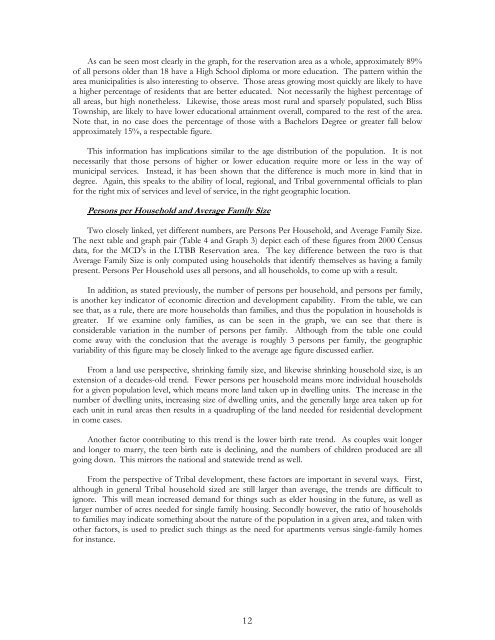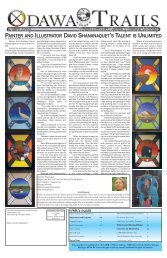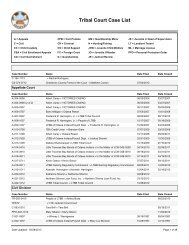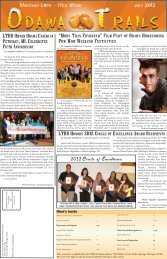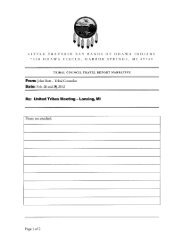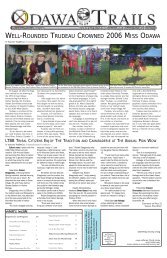LTBB Master Land Use Plan - Little Traverse Bay Bands of Odawa ...
LTBB Master Land Use Plan - Little Traverse Bay Bands of Odawa ...
LTBB Master Land Use Plan - Little Traverse Bay Bands of Odawa ...
You also want an ePaper? Increase the reach of your titles
YUMPU automatically turns print PDFs into web optimized ePapers that Google loves.
As can be seen most clearly in the graph, for the reservation area as a whole, approximately 89%<br />
<strong>of</strong> all persons older than 18 have a High School diploma or more education. The pattern within the<br />
area municipalities is also interesting to observe. Those areas growing most quickly are likely to have<br />
a higher percentage <strong>of</strong> residents that are better educated. Not necessarily the highest percentage <strong>of</strong><br />
all areas, but high nonetheless. Likewise, those areas most rural and sparsely populated, such Bliss<br />
Township, are likely to have lower educational attainment overall, compared to the rest <strong>of</strong> the area.<br />
Note that, in no case does the percentage <strong>of</strong> those with a Bachelors Degree or greater fall below<br />
approximately 15%, a respectable figure.<br />
This information has implications similar to the age distribution <strong>of</strong> the population. It is not<br />
necessarily that those persons <strong>of</strong> higher or lower education require more or less in the way <strong>of</strong><br />
municipal services. Instead, it has been shown that the difference is much more in kind that in<br />
degree. Again, this speaks to the ability <strong>of</strong> local, regional, and Tribal governmental <strong>of</strong>ficials to plan<br />
for the right mix <strong>of</strong> services and level <strong>of</strong> service, in the right geographic location.<br />
Persons per Household and Average Family Size<br />
Two closely linked, yet different numbers, are Persons Per Household, and Average Family Size.<br />
The next table and graph pair (Table 4 and Graph 3) depict each <strong>of</strong> these figures from 2000 Census<br />
data, for the MCD’s in the <strong>LTBB</strong> Reservation area. The key difference between the two is that<br />
Average Family Size is only computed using households that identify themselves as having a family<br />
present. Persons Per Household uses all persons, and all households, to come up with a result.<br />
In addition, as stated previously, the number <strong>of</strong> persons per household, and persons per family,<br />
is another key indicator <strong>of</strong> economic direction and development capability. From the table, we can<br />
see that, as a rule, there are more households than families, and thus the population in households is<br />
greater. If we examine only families, as can be seen in the graph, we can see that there is<br />
considerable variation in the number <strong>of</strong> persons per family. Although from the table one could<br />
come away with the conclusion that the average is roughly 3 persons per family, the geographic<br />
variability <strong>of</strong> this figure may be closely linked to the average age figure discussed earlier.<br />
From a land use perspective, shrinking family size, and likewise shrinking household size, is an<br />
extension <strong>of</strong> a decades-old trend. Fewer persons per household means more individual households<br />
for a given population level, which means more land taken up in dwelling units. The increase in the<br />
number <strong>of</strong> dwelling units, increasing size <strong>of</strong> dwelling units, and the generally large area taken up for<br />
each unit in rural areas then results in a quadrupling <strong>of</strong> the land needed for residential development<br />
in come cases.<br />
Another factor contributing to this trend is the lower birth rate trend. As couples wait longer<br />
and longer to marry, the teen birth rate is declining, and the numbers <strong>of</strong> children produced are all<br />
going down. This mirrors the national and statewide trend as well.<br />
From the perspective <strong>of</strong> Tribal development, these factors are important in several ways. First,<br />
although in general Tribal household sized are still larger than average, the trends are difficult to<br />
ignore. This will mean increased demand for things such as elder housing in the future, as well as<br />
larger number <strong>of</strong> acres needed for single family housing. Secondly however, the ratio <strong>of</strong> households<br />
to families may indicate something about the nature <strong>of</strong> the population in a given area, and taken with<br />
other factors, is used to predict such things as the need for apartments versus single-family homes<br />
for instance.<br />
12


